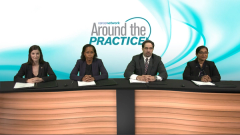
Features of High-Risk Multiple Myeloma and Clinical Trial Landscape
The expert panel provides clinical insights on the key features of high-risk multiple myeloma and a look toward the clinical trial landscape.
Episodes in this series

Transcript:
Al-Ola Abdallah, MD: Leyla, this is a case of high-risk myeloma based on the cytogenetic risk factor. Do you have any comments about the high-risk other features? There are many features of high-risk myeloma.
Leyla O. Shune, MD: This patient that we’ve discussed has extramedullary disease. Even though it’s not regarded as one of the high-risk features, it’s clearly a high-risk feature of myeloma. People who have circulating plasma cells are considered high risk. In this case, his cytogenetic risk factor is that he has a TP53 mutation or 17p deletion, which is definitely a high-risk feature. Other high-risk features include translocation 4;14, translocation 14;16, translocation 14;20, and amplification of 1q. It could be 3 or more [features]. Chromosome 1q amplification is also considered to be a high-risk feature. The are other features of high-risk myeloma done at different centers, but for the general public and from the IMWG [International Myeloma Working Group] criteria, we use the high-risk cytogenetics, extramedullary disease, and circulating plasma cells. These are features of high-risk disease.
Al-Ola Abdallah, MD: That prompts a lot of questions. We’re talking about them as a subgroup, and we’re going through the same mistake because we’re enrolled in the same treatments. In the GRIFFIN trial, we’re talking about daratumumab–RVd [lenalidomide, bortezomib, dexamethasone]. We need to focus on separating that group and trying to find a standard of care. If you look at a lot of algorithms, they always have a different category for these patients and a different lines of therapies. That’s my biggest concern. Is the GRIFFIN trial going to be the standard of care for high-risk myeloma? When I look at many algorithms, they’re not following any clinical trials. They have a different approach for these patients. That’s one of the biggest concerns in high-risk myeloma.
Leyla O. Shune, MD: I agree completely. High-risk myeloma is about 20% of all myeloma cases, which needs to be studied intensely and to improve their outcomes.
Al-Ola Abdallah, MD: I agree 100%.
Leyla O. Shune, MD: Dr Abdallah, please share your thoughts on the lack of clinical trials focusing on high-risk multiple myeloma.
Al-Ola Abdallah, MD: It causes frustration. One of the trials is the SWOG trial. They took patients with high-risk myeloma and enrolled them to get Revlimid [lenalidomide], Velcade [bortezomib], dexamethasone with or without elotuzumab. Let me remind everybody: that’s a good study. Why? Because it’s high-risk myeloma. But they opted not to give them transplants. We don’t have transplant, and they enrolled +1q. There were over 100 patients, so it was 50 vs 50—a small number, but it’s also good.
The results were disappointing, but 4 is better than 3—not every time you add a drug is better. The PFS [progression-free survival] and the overall survival were similar. But that opened our minds that this could be a standard of care that we start with. You can use RVd [lenalidomide, bortezomib, dexamethasone]. When I look at that study, maybe that’s why we still call Velcade a proteasome inhibitor and Revlimid an IMiD [immunomodulatory imide drug], because they’re the backbone for treating high-risk myeloma. But we can’t omit the transplant in these cases. Our adaptation of the proteasome inhibitor and the Revlimid as the main treatments for higher myeloma is coming from the SWOG study. So it’s a significant study.
There are other trials they’re trying to build, but the MASTER study was one of the good ones because 60% of the patients had high-risk myeloma. The designation of the MASTER trial was significant. The 1 negative thing is that it’s only a single arm, so we don’t know the standard of care. But it uses 4 drugs—daratumumab–RVd–[lenalidomide, bortezomib, dexamethasone]—and transplant and then moving on to consolidation therapy with 4 drugs for about 8 cycles and then maintenance Revlimid. They used MRD [minimal residual disease] testing in each session to identify if they can stop the treatment. I like that because it decreases the toxicity. But it still doesn’t answer a lot of questions about the rule for continuing treatment or switching to different maintenance therapy. How much is that going to help in the future?
The study is a good start, but it’s not giving us the real standard care for high-risk myeloma. It’s a good start to see how can we utilize MRD testing. The reason I don’t do MRD testing in the real world is that I don’t know what to do if you tell me the test is negative. In a patient with high-risk myeloma, would stop I the treatment? No, I’m not going to stop the treatment. I want to keep him alive. If the patient is positive, what am I going to do? If there are myeloma markers and no EMD [extramedullary disease] or anything like that, then I’m not going to change the treatment. We need more trials to tell us how to utilize the MRD, what to do with the treatment, how to change the treatment, and how to utilize MRD testing.
Transcript edited for clarity.
Newsletter
Stay up to date on recent advances in the multidisciplinary approach to cancer.



















































































